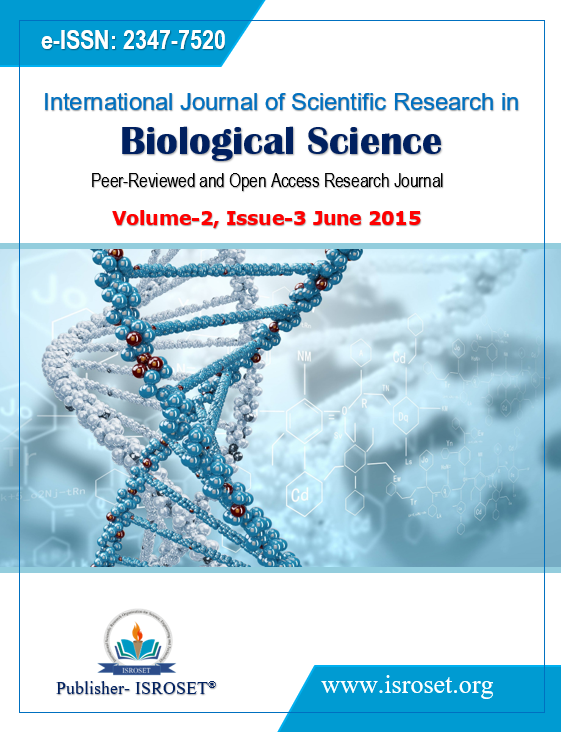Semiochemical Receptors in Steatoda Grossa
Keywords:
Steatoda, Semiochemicals, ReceptorAbstract
Web building spiders are known to have poorly developed eyes, and acoustic organ for communication. Thus the only mechanism possible for mate identification is chemical communication. In nature female spider build a web and male wander around until find a terrestrial pheromones through female silk. Our preliminary experiments have confirmed absence of air borne pheromones. To ensure existence of semiochemicals series of experiment were carried out on a Therididae spider Steatoda grossa between combination of mature male with mature and immature female Steatoda. Male Steatoda when introduced on web of female showed vibration and female also showed vigorous vibration in response to male vibrations. Male responded to female web as soon as he landed on web confirming existence of some kind of identification factor on web which can be semiochemicals. The semiochemicals receptor have been detected on leg of Steatoda grossa through SEM. The receptor are located on the hair arranged in rows concentrating mainly on tarsal segment both the short and long hairs act as receptor for receiving stimulus.
References
Aiesenberg, A., Bauruffadi, L., and Gonzalez, M. Behavioural Evidence of male volatile pheromones in the sex role reversed wolf spiders Allocosa brasiliensis and Allocoasa alticeps. Naturwissenschaften, 97 (63-70)<2010>
Barth, F.G. 1993. Sensory guidance in spider pre-copulatory behavior. Comparative Biochemistry and Physiology 104A:717–733<1993>
Chinta, S.P., Goller, S., Lux, J., Funke, S., Uhl, G., Schulz, S. The sex pheromone of the wasp spider Argiope bruennichi. Ang. Chem. Int. Ed., 49 (2033 -2036) <2010>
Clark, R.J. & Jackson, R.R. Araneophagic jumping spiders discriminate between the draglines of familiar and unfamiliar conspecifics. Ethology Ecology & Evolution, 7 (185–190 ) <1995a >
Clark, R.J. & Jackson, R.R. Dragline-mediated sex recognition in two species of jumping spiders (Araneae, Salticidae), Portia labiata and P. fimbriata. Ethology Ecology & Evolution, 7 (73–77)<1995b>
Dondale, C.D. & Hegdekar, B.M. The contact sex pheromone of Pardosa lapidicina Emerton (Araneida : Lycosidae). Canadian Journal of Zoology 51(400–401) <1973>
Fernandez Montraveta, C. and Ruano Bellido, J. Female silk and mate attraction in a burrowing wolf spider (Araneae, Lycosidae). Buletein of the British Arachnological Society , 11:361-366 <2000>
Gaskett, A.C. Spider sex pheromones: emission, reception, structures, and functions. Biol. Rev., 82(27–48) <2007>
Huber, B.A. Sexual selection research on spiders: progress and biases. Biology Review, 80(363–385)<2005>
Kohl, T.H., Seah, W.K., Yap, L.M.Y.L. and Li.D. Pheromones bases female mate choice and its effect on reproductive investment in a spitting spider. Behavioral Ecology and Sociobiology, 63 (923-930)<2009>
Papke, M.D., Riechert, S.E., and Schulz, S. An Air borne Pheromone associated with male attraction and Courtship in desert spider. Animal Behaviour, 61 (877-886) <2001>
Roberts, J.A. & Uetz, G.W. Species-specificity of chemical signals: silk source affects discrimination in a wolf spider (Araneae: Lycosidae). Journal of Insect Behavior, 17: (477–491)<2004b>
Roberts, J.A. & Uetz, G.W. Information content of female chemical signals in the wolf spider, Schizocosa ocreata: male discrimination of reproductive state and receptivity. Anim. Behav. 70 (217–223)<2005>
Ross, K. and Smith, R.L. Aspects of the Courtship Behaviour of The Black widow Spider, Latrodectus hesperus (Araneae: Therididae), with evidence for the existence of a Contact Sex Pheromone. Journal of Arachnology,7(69-77) <1979>
Rovner, J.S., and Barth, F.G. Vibratory communication through living plants by a tropical wandering spider. Science, 214 (464–466)<1981>
Rypstra, A.L., Weig, C., Walker, S.E and Persons, M.H. 2003.Mutual mate assessment in wolf spiders : differences in the cues used by males and females. Ethology, 109(315-325) <2003>
Schulz, S. Semiochemistry of spiders. In Advances in Insect Chemical Ecology (eds. R.T. Carde and J.G. Millar), pp. 110–150. Cambridge University Press, Cambridge <2004a>
Stoltz, J.A. and Elias, D.O. and Andrade, M.C.B. Females reward courtship by competing males in a cannibalistic spider. Behavioral Ecology and Sociobiology, 62(689–697) <2008>
Suter, R.B. & Hirscheimer, A.J. Multiple web-borne pheromones in a spider Frontinella pyramitela (Araneae, Linyphiidae). Animal Behaviour 34(748–753) <1986>
Suter, R.B., Shane, C.M. & Hirscheimer, A.J. Communication by cuticular pheromones in a linyphiid spider. Journal of Arachnology 15(157–162) <1987>
Symonds, M.R.E. and Elgar, M.A. The evolution of pheromone diversity. Trends in Ecology and Evolution, 23 (220-228)<2008>
Tietjen, W.J. & Rovner, J.S. Chemical communication in lycosids and other spiders. In Spider communication : Mechanisms and ecological significance (eds. P. N. Witt and J. S. Rovner), Princeton University Press, Princeton, NJ. pp. (249–279)<1982>
Wyatt, T. D. Pheromones and Animal Behavior: Communication by Smell and Taste. Cambridge University Press, Cambridge <2003>
Downloads
Published
How to Cite
Issue
Section
License

This work is licensed under a Creative Commons Attribution 4.0 International License.
Authors contributing to this journal agree to publish their articles under the Creative Commons Attribution 4.0 International License, allowing third parties to share their work (copy, distribute, transmit) and to adapt it, under the condition that the authors are given credit and that in the event of reuse or distribution, the terms of this license are made clear.







